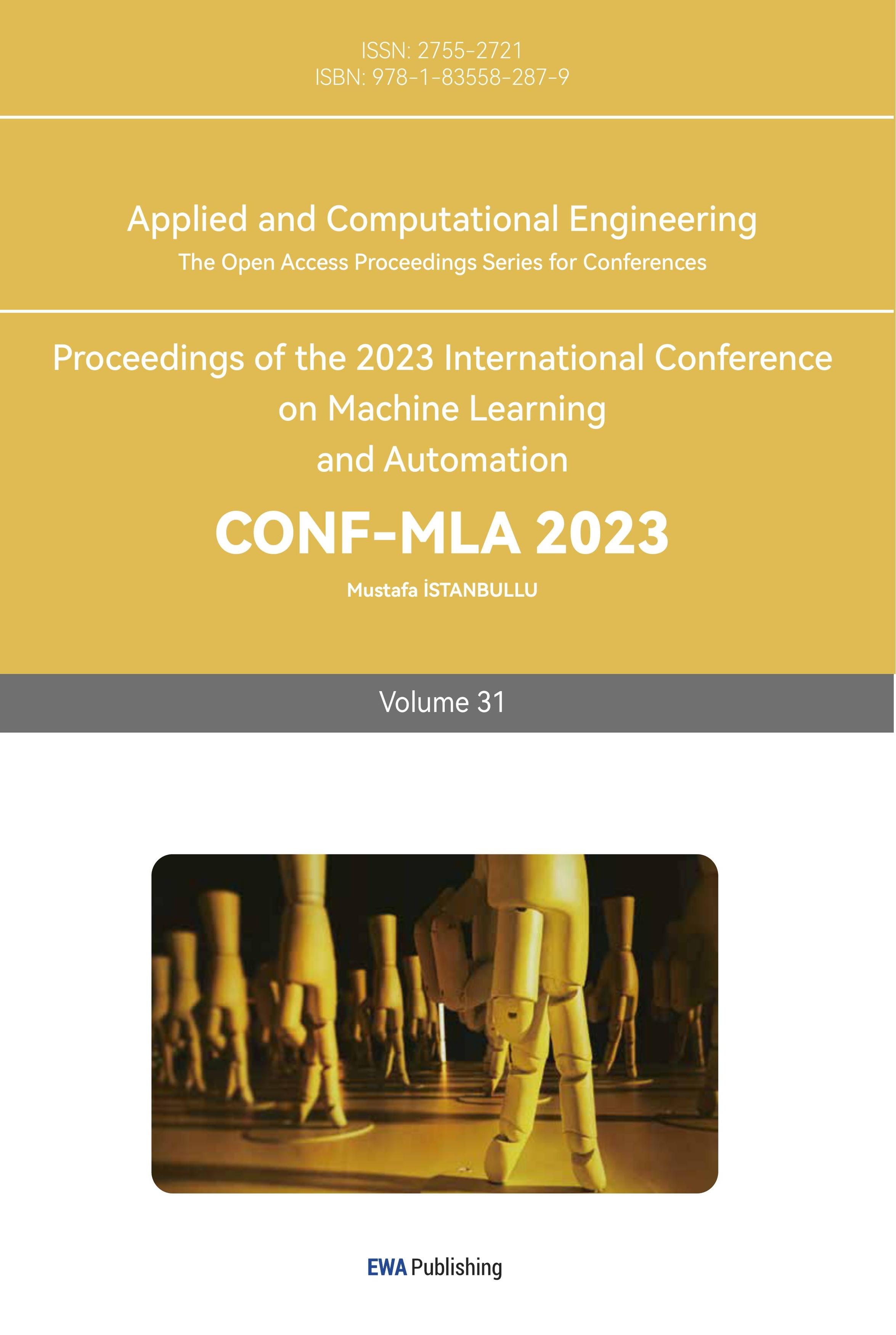References
[1]. Nef T, Guidali M, and Riener R (2009). ARMin III-Arm therapy exoskeleton with an ergonomic shoulder actuation. Applied Bionics and Biomechanics, 6(2), 127-142.
[2]. Li G, Zheng Y, Wu X. (2015). Research progress and trend of medical rehabilitation Robot [J]. Bulletin of Chinese Academy of Sciences, 30(6),793-802.
[3]. Xue X, Deng Z, Sun J, Li N, Ren W, Zhou L, He Y. (2022). Hot spots and frontiers of rehabilitation robot research in recent 10 years: a bibliometric analysis based on the Web of Science database. Chinese Journal of Tissue Engineering Research, 26(14), 2095-4344(2022)14-02214-09.
[4]. Yu H. (2020). Rehabilitation robot: Ten future prospects [J]. Chinese Journal of Rehabilitation Medicine, 35(8), 900-902
[5]. Wang Q, Wei Y, Liu L. (2018). Research and Application Progress of Rehabilitation Robot [J]. Packaging Engineering, 39(18), 83-89.
[6]. Li H, Zhang T, Feng G. (2017). Application progress of exoskeleton lower limb rehabilitation robot in stroke rehabilitation [J]. Rehabilitation Theory and Practice in China, 23(7), 788-791.
[7]. Rodgers H, Bosomworth H, Krebs HI, et al. (2019). Robot assisted training for the upper limb after stroke (RATULS): a multicentre randomised controlled trial. Lancet,394(10192), 51-62.
[8]. Schiele A (2008). Fundamentals of Ergonomic Exoskeleton, Robots [D]. Delft: Technische Universiteit Delft.
[9]. Wu X, Xue H, Huang R, Le Q, Hu X, Yu H (2015). Structural design and analysis of modular wearable exoskeleton upper limb robot, mechanical manufacturing, 1000-4998(2015)08-0026-04.
[10]. Zhu X (2017). Research on control strategy of upper limb motor system of rehabilitation robot [D]. Northeastern University.
Cite this article
Yang,Y. (2024). Study on the safety of elbow joint with simple upper limb rehabilitation exoskeleton. Applied and Computational Engineering,31,157-164.
Data availability
The datasets used and/or analyzed during the current study will be available from the authors upon reasonable request.
Disclaimer/Publisher's Note
The statements, opinions and data contained in all publications are solely those of the individual author(s) and contributor(s) and not of EWA Publishing and/or the editor(s). EWA Publishing and/or the editor(s) disclaim responsibility for any injury to people or property resulting from any ideas, methods, instructions or products referred to in the content.
About volume
Volume title: Proceedings of the 2023 International Conference on Machine Learning and Automation
© 2024 by the author(s). Licensee EWA Publishing, Oxford, UK. This article is an open access article distributed under the terms and
conditions of the Creative Commons Attribution (CC BY) license. Authors who
publish this series agree to the following terms:
1. Authors retain copyright and grant the series right of first publication with the work simultaneously licensed under a Creative Commons
Attribution License that allows others to share the work with an acknowledgment of the work's authorship and initial publication in this
series.
2. Authors are able to enter into separate, additional contractual arrangements for the non-exclusive distribution of the series's published
version of the work (e.g., post it to an institutional repository or publish it in a book), with an acknowledgment of its initial
publication in this series.
3. Authors are permitted and encouraged to post their work online (e.g., in institutional repositories or on their website) prior to and
during the submission process, as it can lead to productive exchanges, as well as earlier and greater citation of published work (See
Open access policy for details).
References
[1]. Nef T, Guidali M, and Riener R (2009). ARMin III-Arm therapy exoskeleton with an ergonomic shoulder actuation. Applied Bionics and Biomechanics, 6(2), 127-142.
[2]. Li G, Zheng Y, Wu X. (2015). Research progress and trend of medical rehabilitation Robot [J]. Bulletin of Chinese Academy of Sciences, 30(6),793-802.
[3]. Xue X, Deng Z, Sun J, Li N, Ren W, Zhou L, He Y. (2022). Hot spots and frontiers of rehabilitation robot research in recent 10 years: a bibliometric analysis based on the Web of Science database. Chinese Journal of Tissue Engineering Research, 26(14), 2095-4344(2022)14-02214-09.
[4]. Yu H. (2020). Rehabilitation robot: Ten future prospects [J]. Chinese Journal of Rehabilitation Medicine, 35(8), 900-902
[5]. Wang Q, Wei Y, Liu L. (2018). Research and Application Progress of Rehabilitation Robot [J]. Packaging Engineering, 39(18), 83-89.
[6]. Li H, Zhang T, Feng G. (2017). Application progress of exoskeleton lower limb rehabilitation robot in stroke rehabilitation [J]. Rehabilitation Theory and Practice in China, 23(7), 788-791.
[7]. Rodgers H, Bosomworth H, Krebs HI, et al. (2019). Robot assisted training for the upper limb after stroke (RATULS): a multicentre randomised controlled trial. Lancet,394(10192), 51-62.
[8]. Schiele A (2008). Fundamentals of Ergonomic Exoskeleton, Robots [D]. Delft: Technische Universiteit Delft.
[9]. Wu X, Xue H, Huang R, Le Q, Hu X, Yu H (2015). Structural design and analysis of modular wearable exoskeleton upper limb robot, mechanical manufacturing, 1000-4998(2015)08-0026-04.
[10]. Zhu X (2017). Research on control strategy of upper limb motor system of rehabilitation robot [D]. Northeastern University.









